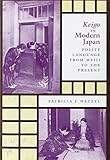Keigo in Modern Japan : Polite Language from Meiji to the Present / Patricia J. Wetzel.
Material type: TextPublisher: Honolulu : University of Hawaii Press, [2004]Copyright date: ©2004Description: 1 online resource (216 p.) : illusContent type:
TextPublisher: Honolulu : University of Hawaii Press, [2004]Copyright date: ©2004Description: 1 online resource (216 p.) : illusContent type: - 9780824826024
- 9780824846688
- 495.6/5 23
- PL629.H65 W4713 2004
- online - DeGruyter
- Issued also in print.
| Item type | Current library | Call number | URL | Status | Notes | Barcode | |
|---|---|---|---|---|---|---|---|
 eBook
eBook
|
Biblioteca "Angelicum" Pont. Univ. S.Tommaso d'Aquino Nuvola online | online - DeGruyter (Browse shelf(Opens below)) | Online access | Not for loan (Accesso limitato) | Accesso per gli utenti autorizzati / Access for authorized users | (dgr)9780824846688 |
Frontmatter -- Contents -- Acknowledgments -- Introduction -- Chapter 1. Keigo in Linguistics -- Chapter 2. Keigo in Kokugogaku -- Chapter 3. Inventing Keigo: Standardization -- Chapter 4. The Modernization of Keigo -- Chapter 5. Keigo Common Sense -- Appendix 1. Keigo from Now On -- Appendix 2. Guidelines for Expressions of Respect (Keii Hyōgen) in the Modern Age -- Notes -- Bibliography -- Index
restricted access online access with authorization star
http://purl.org/coar/access_right/c_16ec
Patricia Wetzel offers in this volume a comprehensive examination of a frequently discussed yet much misunderstood aspect of the Japanese language. Keigo, or "polite language," is often viewed as a quaint accessory to Japanese grammar and a relic of Japan's feudal past. Nothing, Wetzel contends, could be further from the truth. It is true that Japan has a long history of differentiating linguistic form on the basis of social status, psychological detachment, emotional reserve, and a host of other context-dependent factors. But, as is made clear in this unique and broadly framed study, modern keigo consciousness and keigo grammar emerged out of Japan's encounter with Western intellectual trends in the mid- to late nineteenth century. Keigo in Modern Japan presents a finely nuanced linguistic and political review of keigo available nowhere else in English.The first chapter outlines the ways in which keigo has been problematized in Western linguistics through the application of structuralist analysis and its offshoots. But keigo's presence in the English-language literature does not begin to compare with the place it occupies in the Japanese linguistic canon. Wetzel describes the historical roots and growth of keigo and the popularity of how-to manuals, which, she contends, are less about overt instruction than reinforcing what people already believe.
Issued also in print.
Mode of access: Internet via World Wide Web.
In English.
Description based on online resource; title from PDF title page (publisher's Web site, viewed 02. Mrz 2022)


